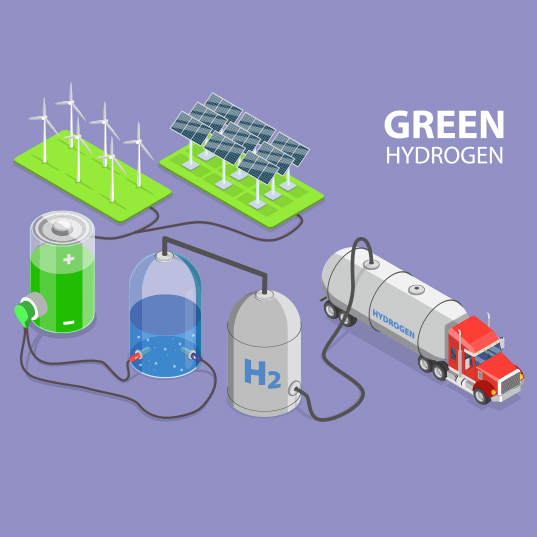The scientific community is repeating it tirelessly: mitigating the effects of climate change means abandoning the burning of fossil fuels. The latest news from some European countries about the reopening of coal-fired power plants due to the war in Ukraine is a step backwards in this essential objective for the planet. But time is running out. Greenhouse gas emissions continue to accumulate, fuelling the rise in global temperatures. The alternatives? Renewable energies and new fuel sources such as hydrogen.
If we talk about this second option, the problem for now is that grey hydrogen is the most widespread, and blue hydrogen positions itself as another option that is slightly less bad than the previous one.
So, at this point, when it comes to hydrogen, the only viable, clean and sustainable possibility is green hydrogen.
What will I read in this article?
- Grey hydrogen: few pros and many cons
- Blue hydrogen: advantages and disadvantages
- The role of green hydrogen in the energy transition
Grey hydrogen: no alternative, no solution
 If the world is to decarbonise the economy, hydrogen will play a vital role. So says the Intergovernmental Panel on Climate Change's report on climate change mitigation, which was signed by all 193 governments at the UN.
If the world is to decarbonise the economy, hydrogen will play a vital role. So says the Intergovernmental Panel on Climate Change's report on climate change mitigation, which was signed by all 193 governments at the UN.
It’s the most abundant element in the world and stands out as a light and storable energy carrier. As a secondary characteristic, it’s also invisible. So why such a wide range of colours to refer to it?
It all depends on the form in which it is obtained. What happens is that hydrogen is not found on its own, but must be separated from other elements. During this process, the only waste it generates by itself is water. The same is not true for the energy used to break it down.
Not all types of hydrogen are sustainable. Grey hydrogen is precisely the hydrogen we obtain from fossil fuels, natural gas being the most common. It’s the cheapest hydrogen to produce at the moment, and it’s also the most common. Most of the hydrogen currently consumed is grey hydrogen.
As a result, hydrogen production is responsible for emitting around 830 million tonnes of carbon dioxide per year, according to the International Energy Agency (IEA). This is equivalent to the CO₂ emissions of the UK and Indonesia combined.
So, in reality, grey hydrogen represents no alternative to mitigate the effects of climate change. Rather, it perpetuates an energy system based on fossil fuels and carbon emissions.
What about blue hydrogen?
Blue hydrogen is also obtained from fossil fuels, but with techniques capable of capturing and storing CO₂ emissions produced. It is somewhat less polluting than grey hydrogen, but blue hydrogen is only capable of reducing emissions during its production process, rather than eliminating them completely.
"Blue hydrogen is only capable of reducing emissions during its production process, rather than eliminating them completely".
According to the International Renewable Energy Agency (IRENA), CO₂ capture efficiency is expected to reach 85-95 % at best, which means that 5-15 % of all CO₂ is filtered out.
The role of green hydrogen in the energy transition
Also called renewable hydrogen, green hydrogen is mainly produced by electrolysis of water from an electric current. It is green if the electricity used is generated by renewable energies, such as wind or solar power. This process does not emit greenhouse gases or polluting waste. In fact, the only waste it leaves behind is water.
It’s the cleanest and most sustainable hydrogen. However, its implementation and development are lagging behind. As a result, less than 1% of the hydrogen produced worldwide is green.
"Less than 1% of the hydrogen produced globally is green".
 The IPCC says this clean fuel will be key to meeting the challenges of decarbonisation, such as in heavy transportation. Hydrogen can store energy until it needs to be used. This provides a back-up for renewable energies and allows the surplus energy they produce to be stored in the form of green hydrogen.
The IPCC says this clean fuel will be key to meeting the challenges of decarbonisation, such as in heavy transportation. Hydrogen can store energy until it needs to be used. This provides a back-up for renewable energies and allows the surplus energy they produce to be stored in the form of green hydrogen.
It also opens up an opportunity for the transport and trade of this fuel among different regions. The report also points out that it will be key to decarbonising those industrial sectors that are difficult to electrify, such as the iron and steel, petrochemical and chemical industries, as well as heavy transportation.
As we’ve seen in previous articles, there’s still some way to go to make green hydrogen an important pillar of an emission-neutral economy. For now, the outlook is positive and commitments to green hydrogen are increasingly ambitious on the part of both the private sector and governments.
Sources: